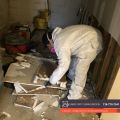The Ultimate Homeowner's Guide to Mold Management

Mold is more than just an unsightly nuisance; it can pose serious health risks and damage the structural integrity of your home. For homeowners and landlords in the Bay Area, where humidity and moisture are prevalent, understanding how to manage mold is essential. This comprehensive guide covers everything from the types of household mold and their severity levels to legal responsibilities and professional mold consulting services.
Different Types of Household Mold
Mold comes in various forms, each with distinct characteristics and risks. Understanding these types can help you identify and address mold problems effectively.
- Aspergillus: This common mold often appears in damp, warm environments and can cause respiratory issues. It’s typically found in areas like kitchens and bathrooms and ranges in color from white to green.
- Cladosporium: Often found on wood, carpets, and fabrics, Cladosporium can trigger allergies and asthma. It usually presents as black or green spots.
- Stachybotrys Chartarum (Black Mold): Known for its dark color and slimy texture, black mold thrives in areas with significant water damage. It can produce toxins that lead to serious health problems, including respiratory issues and chronic fatigue.
- Penicillium: This mold type is commonly found on water-damaged materials like wallpaper, carpet, and insulation. Penicillium is recognizable by its blue or green color and can cause allergic reactions and asthma.
- Alternaria: Frequently found in damp areas such as showers, basements, and under sinks, Alternaria can cause allergic reactions and is usually dark green or brown.
The Different Levels of Household Mold Explained
Understanding the severity of mold contamination is crucial for determining the appropriate response. Mold levels are typically categorized as follows:
- Level 1: Small Isolated Areas (10 square feet or less)
- This level involves minor mold growth, often on walls or ceilings. It’s generally safe to clean these areas yourself using household cleaning solutions and protective gear.
- Level 2: Mid-Sized Areas (10-30 square feet)
- At this stage, mold growth may require the removal of contaminated materials like drywall or carpet. Protective measures should be taken to prevent the spread of mold spores.
- Level 3: Extensive Contamination (30-100 square feet)
- Large areas of mold indicate more serious underlying moisture problems. Professional remediation is often necessary to ensure all mold is removed and future growth is prevented.
- Level 4: Severe Infestation (100 square feet or more)
- When mold contamination spreads across large areas, it can compromise the structural integrity of your home and pose significant health risks. Immediate professional intervention is required to remediate the mold and address the source of moisture.
Different Ways to Check Mold Levels in Your House
Detecting mold early can prevent small problems from becoming major health hazards. Here are some effective methods to check for mold in your home:
- Visual Inspection: Regularly inspect areas prone to moisture, such as bathrooms, kitchens, basements, and around windows, for signs of mold, including discoloration and spots.
- Odor Detection: Mold often emits a musty smell. If you detect such an odor, it could indicate hidden mold, particularly in areas that are not easily visible.
- Moisture Meters: These devices can measure moisture levels in walls, floors, and ceilings, helping you identify areas that may be at risk for mold growth.
- DIY Mold Test Kits: Available at hardware stores, these kits allow you to collect samples and send them to a lab for analysis, giving you a clearer picture of the mold types and concentrations in your home.
- Professional Mold Inspection: For a thorough and accurate assessment, consider hiring a certified mold inspector. Professionals like those at Bay Area Mold Pros use advanced tools and techniques to detect mold in hard-to-reach areas and provide a comprehensive report.
How Long Does a Landlord Have to Fix a Mold Problem?
Landlords have a legal obligation to maintain habitable living conditions, which includes addressing mold problems in a timely manner. The timeframe for fixing mold issues can vary:
- Immediate Action Required: If a tenant reports visible mold, landlords are typically required to address the issue within 14 to 30 days, depending on local regulations. Prompt action is essential to prevent the problem from worsening.
- Legal Requirements: In California, landlords must ensure that rental properties are free from hazardous mold. Failure to act within a reasonable timeframe could lead to legal consequences, including fines or lawsuits for breach of habitability.
- Tenant Notifications: Tenants are responsible for reporting mold issues promptly. Delays in reporting can complicate the landlord’s ability to fix the problem quickly.
Who’s Responsible for Mold in a Rental Property?
Determining responsibility for mold in a rental property involves understanding the duties of both landlords and tenants:
- Landlord Responsibilities: Landlords must provide a safe and habitable environment, which includes taking steps to prevent and address mold. This typically involves fixing leaks, ensuring proper ventilation, and repairing any water damage promptly.
- Tenant Responsibilities: Tenants are responsible for maintaining cleanliness and reporting any conditions that could lead to mold growth, such as leaks or excessive humidity. Negligence in these areas can result in shared responsibility for mold-related damages.
- Legal Recourse: If a landlord fails to address mold issues in a timely manner, tenants may have the right to withhold rent, pay for repairs, or even terminate the lease, depending on the severity of the issue and local laws.
Case Studies: Real-Life Mold Issues and Solutions
Case studies provide valuable insights into how mold problems are identified and resolved. Here are a few examples:
Case Study 1: Hidden Mold in a Bay Area Rental
A tenant in a San Francisco apartment noticed a persistent musty odor but could not locate visible mold. A professional inspection by Bay Area Mold Pros revealed extensive mold growth behind the walls due to a hidden plumbing leak. The landlord promptly arranged for repairs and mold remediation, preventing further damage and health risks.
Case Study 2: Mold After a Severe Storm
After a heavy rainstorm, a homeowner in Oakland discovered mold growing in the attic. The mold was caused by a roof leak that had gone unnoticed. Bay Area Mold Pros conducted a thorough inspection, identified the source of moisture, and recommended a full remediation plan, including roof repair and mold removal.
Case Study 3: Mold in a Newly Purchased Home
A couple in Berkeley purchased a home, only to find mold in the basement a few months later. They hired Bay Area Mold Pros for an inspection, which revealed that the mold was due to inadequate drainage around the foundation. The consulting team provided a comprehensive solution, including improving drainage and complete mold remediation.
Mold Consulting Services in the Bay Area
Dealing with mold can be complex, and professional guidance is often necessary to ensure the problem is fully resolved. Bay Area Mold Pros offers expert consulting services tailored to the unique needs of homeowners and landlords in the Bay Area. Their services include:
- Comprehensive Mold Inspections: Led by certified inspector Rick Bruce, Bay Area Mold Pros conducts detailed inspections using state-of-the-art equipment to detect mold, even in hidden areas.
- Mold Testing and Analysis: They offer thorough testing services to identify mold types and concentrations, providing you with the information needed to make informed decisions.
- Customized Remediation Plans: Based on inspection and testing results, Bay Area Mold Pros provides tailored recommendations for remediation, ensuring that mold issues are addressed effectively.
Why Choose Bay Area Mold Pros?
- Certified Expertise: Rick Bruce is a certified mold inspector with extensive experience in the field.
- Advanced Technology: The team uses cutting-edge tools and techniques to ensure accurate detection and effective solutions.
- Local Knowledge: With a deep understanding of the Bay Area’s unique climate and housing conditions, Bay Area Mold Pros offers services that are specifically designed to address the region's mold challenges.
For professional mold inspection and testing services, contact Bay Area Mold Pros at (650) 762-6228 or visit Bayareamoldpros.com to request an inspection.






